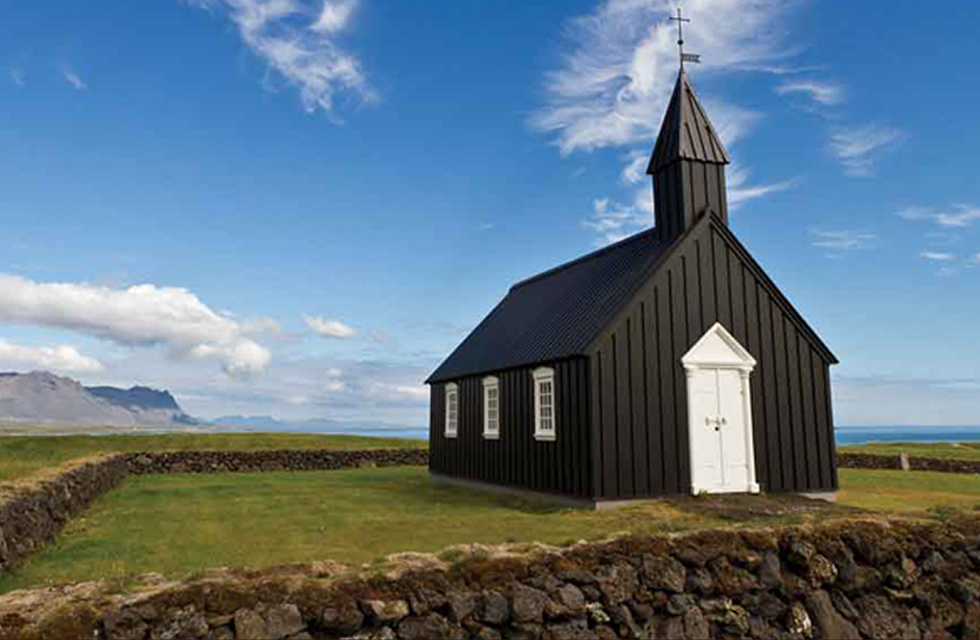Legend and superstition play an essential role in everyday life in Iceland, a country where the fury of the elements is never far from the mind. By Andy Jarosz
To the uninitiated, it may look like an unremarkable rock, bulging out from a residential garden and covered in a generous coat of sodden grass. Yet this is no ordinary rock: it is a dwarf stone, as our guide Sibba explains. She tells us that it was here in the 1920s that a man wanted to build a house and needed to clear the rock from the middle of his land. However hard he tried, he couldn’t move or break it. Eventually an old man from the village saw what he was doing and told him, “A dwarf lives here and he doesn’t want to move.” The man immediately altered his building plans, leaving the rock unmoved, and the inhabitants of the house have lived peacefully since.
Sibba is wearing a bright red felt hat and looks more than a little elf-like as she leads us through the residential streets of Hafnarfjördur on this most unusual of tours, a guided walk in search of the Huldufólk, or the ‘hidden people’ of Iceland – elves, trolls and fairies. This small fishing town close to Reykjavik is considered by those in the know to be Iceland’s elf capital – and as I discover, Icelandic people are deeply superstitious when it comes to the inhabitants of a parallel world. Hidden people stories are an integral part of Icelandic culture and whatever you believe, they certainly reinforce a strong bond between people and their natural surroundings.
angering the elves
As Sibba stops at various places in the town she reveals more stories of elf encounters. She describes how on Elf Hill Road in nearby Kopavogur, the authorities wanted to make the road wider. Engineers tried to move a giant rock with their diggers but had little success. The drills in the diggers kept breaking and when they replaced them, the machinery itself would stop working. Older men on the construction site became nervous and stopped reporting in for work – they didn’t want to be associated with the project, fearing that the elves were angry. The rock was left unbroken and is now a National Monument with the road diverted around it, although many people believe the elves have long moved out due to the noise and the bright streetlights.
We move on to Hellisgerdi Park and the base of the Hamarinn lava cliff, where, Sibba tells us, the Royal Family of elves lives and where people have seen ladies with flowing robes. She recalls a 10-year old girl from Kentucky on a previous tour who stood in the park and exclaimed, “There are so many elves – they are everywhere!” Her mother later explained to Sibba that her daughter “sees many things that we don’t see”.
Even in the church in Hafnafjordur there is another dwarf stone that has been left untouched. As Sibba explains to us, many Icelanders are comfortable practising their Christian faith while tolerating and respecting the country’s traditional beliefs.
If the prospect of seeing elves at first-hand is enough for people to book the next flight to Iceland, Sibba does provide a word of warning. So many people have joined her tour in the hope of an encounter that she now announces at the beginning that “Elf sightings are not included.”
viking origins
Back in Reykjavik, I walk along the shore road for a dose of reality and wander briefly into Harpa, the futuristic glass-covered concert hall that opened in 2011. From here it’s a short stroll to the modest Parliament House and Tjornin Lake, a favourite spot for the city’s residents to exercise and for families to feed the ducks. Reykjavik may be a capital city, but it feels a lot more like a small town.
I head underground into Reykjavik 871, one of the city’s newest museums, to better understand Iceland’s Viking roots. The museum sits on the site of a 10th century longhouse that was uncovered during construction work and state-of-the-art multi-media gadgetry has been cleverly employed to offer visitors an intriguing glimpse of life in the city’s early years.
Back above ground, I wonder along Laugavegur, the city’s main shopping street. It doesn’t take me more than an hour’s gentle stroll to explore the limited range of souvenir shops and expensive boutiques before I stop at Te & Kaffi for a mug of coffee and a spot of people-watching. I talk to a woman next to me and mention the elves and hidden people. When I ask if she believes, she laughs dismissively. Then after a short pause, she adds quietly, “But my mother used to see them all the time.”
WAY TO GO
Discover the World offers holidays all over Iceland, from short breaks to self-drive tours, family holidays, whale-watching and Northern Lights trips. There’s even a hiking tour in the eastern fjords around Borgarfjordur Eystri, In the Footsteps of Elves, on which a local guide explains some of Iceland’s myths and legends. Tel. 01737 214 291 / www.discover-the-world.co.uk.
Reykjavik Excursions offers a huge range of day trips in Iceland, from popular sights like the Golden Circle tour and the Blue Lagoon thermal pool to horse riding, ice climbing, Northern Lights spotting and in winter, the extraordinary experience of snorkelling in a fissure in Thingvellir National Park, with 100m of visibility and astonishing underwater landscapes. Book online at www.re.is.
At the more bespoke of the market, Luxury Adventures offers an endless list of activities, whether it be skiing down an active volcano, diving between Europe and America’s tectonic.
